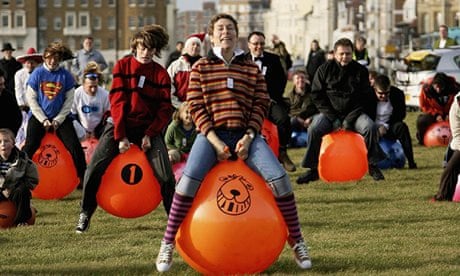Aquilino Cosani, designer
In the early 1960s, I was watching a documentary about kangaroos and I realised that children never look as happy as when they're jumping. So I decided to make a toy that let them bounce around like kangaroos.
I tried out various prototypes for the bouncy ball part. It was important that all the testing was done by children, not adults. So after getting feedback from my sons and lots of others, I then attached a rigid handle to my ball and called it the Pon-Pon, after the sound it made when anyone bounced on it. I didn't want a colour that could be associated with either gender, so I excluded blue and pink, eventually choosing orange because it was intended to be used outdoors in summer, and orange seemed very sunny. We decided to make it out of PVC because of its elasticity and durability.
After it launched at the Nuremberg Toy Fair, it became more successful than I ever imagined. Over the years, we replaced the rigid plastic handle with a soft one that's the same material as the ball – and renamed it the Hop. We never licensed the design, so different kinds cropped up all over the world. In 1968 Ledragomma, my company, patented just the handle, so other companies could make their own versions with different handles and their own names, to get round the patent. We weren't worried: the market was big enough for all of us. A British company called Wembley made some changes to the design and called it the Space Hopper. The Americans called theirs the Hoppity Hop.
Roger Brown, Wembley marketing director
In 1972, when I joined Wembley, the Space Hopper was already in our range. One of our team had seen a child in Italy playing on this bouncy thing, so took the idea, changed the handle into horns and created a creature that was meant to look like a space animal.
Our Space Hopper was tear-shaped rather than round like the Italian one, but it was still made it out of PVC. Imagine two bowl-like moulds the same size, one with horns. You pour the liquid into one, put the other on top, then spin them so the liquid coats the inside of both bowls and fills the horns. Then you bake it, take the top bowl off, stick in a valve to inflate it – and there's your hopper.
You had to use just enough liquid to get the right thickness, but not too much or you'd get lumps. Each one was blown up to test it for leaks, at which point the famous face was sprayed on. It gave it character and that's what made it so successful: kids everywhere could relate to that big goofy grin.
As a marketing man, I knew it had incredible potential. We struck a deal with Butlins so all their camps ran Space Hopper races. Then we did some TV ads where we took them out of context. In one, we had businessmen in bowler hats with their chauffeurs in front of them, all on hoppers, hopping in a line. We did another at a racecourse, where the jockeys were riding hoppers instead of horses.
At its peak, when it was a national craze, we must have been selling 200,000 a year. Later, we did a Womble hopper and a four-legged animal hopper for preschool children, who held on to its ears. But none of them were anything like as successful.
There was a knack to riding them. Hopping could make your bottom very sore, but once you got the hang of them, it was really exciting. You could ride it on your own or in a team. Boys used them like horses and held jousting tournaments, squirting water at each other from washing-up liquid bottles, while girls would dress them up and make them into characters who lived in their bedrooms. But the best trick was to fill one with water then pull the plug out – you'd get a big jet of water.

Comments (…)
Sign in or create your Guardian account to join the discussion